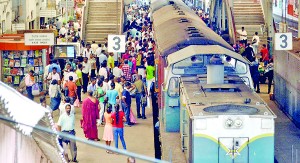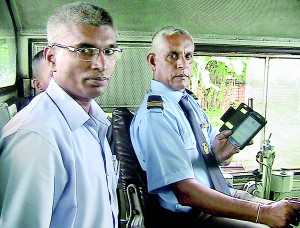News
Modern tech to optimise train movement
With Android phones being fixed to engines, the woes of train commuters whose common complaint is delays, will soon be eased.
To be tried out initially on the coastline between Colombo Fort and Matara starting next month (November), the ‘Train traffic optimisation system’ has become a reality due to the tireless efforts of Research and Development Officer Anura Pushpakumara Kasthoori (46) of the Department of Railways.

The new system will initially be launched on the coastline between Colombo Fort and Matara. Pic by Hasitha Kulasekera
Explaining that train travel has been riddled with numerous issues due to time-tables not being drawn up in a scientific manner and routine errors, as real-time data are not being used, Mr. Kasthoori who had been tasked with studying the issues has now come up with a solution.
With a train considered “a moving robot”, his solution is for the Android operating system programmed device in the engine room to relay real-time data through GPS (global positioning system) and GPRS (global positioning receiving subsystem) to a central server at the Telecom internal data centre in Colombo Fort.
With the data thus relayed from the Coast Line being studied and analysed for six months, the Railway Department would be able to come up with a master time-table. Thereafter, a Google map will show officers at the Maradana Train Control Office, the trains travelling along their tracks, what speed they are travelling at and whether there are delays, points out Mr. Kasthoori.
According to his vision, under this three-year project, LED screens could display the electronic time-table and people may even be able to get train arrival and departure times on their mobiles so that they could adjust their work schedules accordingly without kicking their heels at railway stations and cursing the department.
“The full benefits will be reaped only after about two years,” assures Mr. Kasthoori, adding that the study of real-time data and train dynamics would help in the time-table being adjusted with an added benefit being accident reduction as driver-to-control room and also driver-to-driver communication being easy.
Under the current system, train times cannot be predicted, he explains, pointing out that there are three “different” operations for networking. They are:
• The Centralised Traffic Controlling (CTC) system under which the Control Office in Maradana uses signals and colour lights to allow trains to proceed or to halt them. This system works on the Maradana-Pallewela, Maradana-Wadduwa and Maradana-Negombo lines.

All aboard: The brains behind the Train traffic optimisation system Anura Pushpakumara Kasthoori (left) with an engine driver. Pic by Reka Tharangani
• Under the Local Operating System, once again colour lights and signals are used by the Train Controller at a particular spot after getting the required information over the phone from the relevant Station Master
• Under the Tablet System which is electrically controlled, only one train is allowed per block. Although considered a very safe system, it has become obsolete across the world and been replaced by computers.
The ‘Train traffic optimisation system’ which is now on the cards and is part of the ‘Railway Management System’ had been mooted by Mr. Kasthoori as a research proposal he submitted last year (2012) to the National Research Council (NRC) under the Science and Research Ministry, which is directed by President Mahinda Rajapaksa.
“This is my M.Phil research project at the School of Computing of the Colombo University,” he says, adding with humility that it was selected as one of the best and awarded Rs. 2.5 million by the NRC. While he has been guided by his M.Phil supervisor, the very experienced Dr. Kasun de Soyza, on the side of the Railway Department there has been much support from General Manager B.A.P. Ariyaratne, Additional General Manager (Technical) S.M. Abyewickrema, Deputy Mechanical Engineer (Projects & Development) A.D. Wickremasinghe and Chief Superintendent of the Railway Stores, S.M. Nirmala Ganasinghe.
The project came somewhat naturally to Mr. Kasthoori because he knows the Railway like the back of his hand, having joined the department in 1992 as a locomotive driver. Be it the Northern Line, the Main Line up to Badulla, the Colombo-Kandy line, the Maho-Trincomalee line, the Gal-Oya-Batticaloa line, the Kandy-Matale line, the Coast Line up to Matara or the Kelani Valley line up to Avissawella, he has travelled them all, manning a train engine.
It was in his precious free time that he followed a degree in IT and Computer Science at the Colombo University’s School of Computing.
With his IT knowledge coming in handy, when he was studying the current system that he realized that the shortcomings impeded an increase in track capacity. When giving information over the phone, human error crept in causing not only delays but also congestion, he says.
This is why he has come up with a system to mitigate these shortcomings with the objectives of increasing track capacity, proper implementation of train routes and a time-table based on real-time data.
An automated train controlling system without human intervention as followed in the developed world is Mr. Kasthoori’s dream for Sri Lanka.

